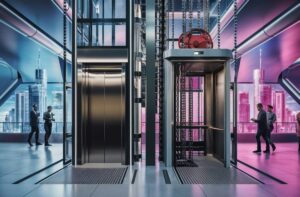Gone are the days when home lifts seemed like bulky, intrusive contraptions. Modern technology has transformed them into space-saving marvels that are surprisingly easy to install. This guide will equip you with the knowledge to monitor progress, understand the technical aspects, and ensure a smooth home lift installation.
Where Will the Elevator Be Located?
The location of the elevator depends on whether the house has already been constructed. If the home is yet to be built, an elevator shaft can be designed accordingly. For discreet placement, it can be positioned near an external wall or within a garage or storage area, preserving the main floor space of the house.
Customized Solution:
The beauty of modern home elevator lies in their adaptability. Forget the idea of a one-size-fits-all solution. Home lifts come in a wide range of sizes and styles, catering to various needs and aesthetics. Some models boast a compact footprint as small as 910 mm by 650 mm, perfect for maximizing space. Incredibly, advancements have led to pit-free and machine room-free options, eliminating the need for major construction.
The appearance and interior design of the elevator can be tailored and adorned to meet the preferences of the building’s occupants. For instance, the shaft or carriage can be adorned with colors that harmonize with the surrounding environment.
Furthermore, in response to the pandemic, Professional Elevators offers the option to equip your elevators with non-contact buttons, prioritizing passenger safety. The specifications of the elevator, including car type, capacity, and number of stops, can be customized to suit the requirements of the building.
What is the key to this versatility? Customization! Reputable elevator companies will offer comprehensive consultations, where they’ll discuss your vision, assess your space, and design a lift that seamlessly integrates into your home. Whether you prioritize sleek minimalism or a touch of old-world charm, there’s a lift solution waiting to be tailored to your preferences.
Home Elevator Cost
The cost of a home elevator as well as some general financial planning. The cost of a two-story residential elevator in the traditional design is approximately $30,000, with an extra $10,000 for each storey beyond that. This represents the average cost for conventional machinery. A unique cab finish or more cab entrances may result in a large price adjustment.
A number of criteria, such as the type of elevator, the number of floors, the style of the cab, the location, and the installation difficulty, will also have a significant impact on the price. An illustration of this would be a standard two-story hydraulic elevator installation.
Is there an affordable home lift?
You’ve probably seen shaftless elevators or customized home lifts if you’ve been looking up information on residential elevators. These elevators are frequently promoted as an inexpensive elevator alternative. Even though the project’s total cost will be reduced, it’s crucial to understand that the savings come from decreased construction costs rather than from the elevator itself.
Although the building changes required to install an elevator in your home can cost as little as $5,000–8,000, a high-quality shaftless elevator will still cost over $25,000. Although less expensive, this kind of elevator can only move a certain distance vertically, can only pass through a single floor according to the current A17.1 regulation, and can typically carry less weight.
1. Shaftless Home Elevators
Shaftless home elevators are compact residential lifts designed to integrate seamlessly into your home with minimal installation disruption. They serve as an excellent alternative to stair lifts or conventional full-sized elevators and are primarily used for enhancing convenience and mobility. Available in both standard and larger sizes, these elevators accommodate wheelchairs and walkers, supporting independent living. This accessibility makes them increasingly popular among seniors and the aging-in-place movement.

Understanding Shaftless Elevators
Shaftless elevators operate without a traditional elevator shaft. This is accomplished by using “push and hold” style buttons on the control panel and sensors installed on the exterior of the elevator. Such elevators are restricted to traveling between a single floor opening. For homes spanning more than two floors, alternatives like hydraulic elevators or MRL (Machine Room Less) traction models are available, detailed in our home elevator guide.
These elevators have a minimal footprint, making them ideal for installation in the most confined spaces. Their compact design allows for easy retrofitting in existing homes, with possible installation locations being virtually limitless. They do not require a pit or a separate machine room, which conserves additional space.
Although they do not necessitate a full shaft, a partial enclosure may be employed. This is beneficial in scenarios where the elevator needs to be integrated into a floor plan with existing walls. For instance, elevators have been successfully installed in modified closets and pantries to create a semi-enclosed hoist. Shaftless elevators can be installed openly or semi-enclosed, as demonstrated in various setups.
2. Space-Saving Platform Elevator:
You can modify the elevator platform to fit the available space if it’s limited. Customizing your elevator involves more than just the cabin; it includes the option to select your preferred type of motor, whether drum, traction, or hydraulic. To minimize costs and space, you might choose a semi-automatic sliding door. The platform will operate vertically within a covering shaft. For safety, a door contact mechanism ensures that the door remains closed unless the elevator is on your floor. In this setup, only a landing door is required, eliminating the need for an additional cabin door and further reducing costs.
The power box can be positioned wherever it is most convenient, as this elevator type does not require a separate machine room or pit. The MRL (Machine Room Less) machine can be mounted above the cabin and operates via a pulley system.

Maximize Functionality in Tight Spaces
Constrained by square footage? Don’t compromise on accessibility! Here’s how to customize your elevator for a perfect fit:
- Platform Tailoring: Gone are the days of one-size-fits-all. Tailor the platform dimensions to your exact spatial constraints, ensuring optimal use of the available space.
- Drive System Flexibility: Not all elevators are created equal. Choose your motor type (drum, traction, or hydraulic) based on factors like weight capacity and desired speed.
- Cost-Saving Doors: Opt for a semi-automatic sliding door to minimize both cost and the elevator’s footprint. This option provides a secure and space-efficient entry/exit point.
- Eliminating Cabin Doors: The elimination of cabin doors, supported by the use of a landing door, significantly reduces costs and lightens your budget.
Prioritizing Safety:
- Built-in Interlock: Never worry about a door opening mid-travel. An integrated door interlock system ensures the doors remain firmly closed when the elevator isn’t level with your floor, prioritizing passenger safety.
- Landing Door Advantage: Forgo the need for an additional cabin door by utilizing a landing door only. This clever design reduces costs and further minimizes the elevator’s overall footprint within your building.
There is another kind of lifting solution that is affordable and possible for instant installation with stairs for the elderly. To learn more about it, read another article.
Flexible Placement Options:
- Machine Room Liberation (MRL): Ditch the dedicated machine room! The power box and motor (MRL) can be conveniently positioned anywhere, eliminating the need for additional construction. This MRL system mounts neatly above the cabin and operates via a space-saving pulley system.
Planning for Success:
Before embarking on your elevator installation journey, consult with a qualified facility manager or elevator technician. Their expertise can confirm the feasibility of your plans and ensure compliance with all relevant safety codes, such as ASME A17.1. This collaborative approach guarantees a smooth installation process and an elevator solution that perfectly meets your needs.
A Step-by-Step Guide to Installation:
Now that you know about the exciting world of custom home lifts, let’s delve into the installation process itself:
- Survey: An expert from the lift company will visit your home to get a firsthand understanding of your needs and preferences. This includes discussing the number of floors you want to access, your desired style, and conducting a thorough assessment of your existing space.
- Technical Solution Proposal: Based on the information gathered during the survey, the company will craft a technical solution proposal specifically for your home. This proposal will detail the ideal number of stops, the most suitable size and materials for the lift, and, of course, the design that complements your taste.
- Financial Planning: Lift suppliers understand that budget is a crucial consideration. They should present various financial options to ensure you find a solution that aligns with your financial goals, making your dream home a reality.
- Custom Lift Production (Optional): For those who crave a truly unique touch, some companies offer the option of custom lift production. This means they can design and manufacture a lift that reflects your individual style and any specific requirements you may have.
- Installation and Handover: Once the lift is manufactured (or imported, if you choose a pre-made model), the company will take care of the installation process. They’ll ensure the lift is meticulously installed in your home and provide a comprehensive handover session. This typically takes around 15–20 days, and the best part? The lift can be immediately connected to your existing power grid, ready to use right away.
- After-Sales Services: A reputable lift company will prioritize your long-term satisfaction. Be sure to inquire about the after-sales services offered. This typically includes regular maintenance checks to guarantee the smooth operation, safety, and longevity of your home lift.
Conclusion:
However, certain critical components of the elevator, such as safety mechanisms, cannot be customized as they are engineered for optimal safety. Altering these components would jeopardize the overall safety and reliability of the elevator, rendering it unsuitable for use.
While the installation itself is a streamlined process, empowering yourself with knowledge is key. Familiarize yourself with the technical specifications of your home lift, understand the integrated safety features, and learn proper usage protocols. Knowing how to handle unexpected situations will provide peace of mind and ensure you get the most out of your home elevator.











Greetings! elevatorstale.com
Did you know that it is possible to send message effectively and legally? We present a new way of sending letters through feedback forms.
Because Communication Forms are seen as important, any messages sent through them are less likely to be categorised as spam.
Take advantage of our free service!
We can transmit a maximum of 50,000 messages for you.
The cost of sending one million messages is $59.
This message was automatically generated.
Please use the contact details below to get in touch with us.
Contact us.
Telegram – https://t.me/FeedbackFormEU
Skype live:feedbackform2019
WhatsApp +375259112693
WhatsApp https://wa.me/+375259112693
We only use chat for communication.